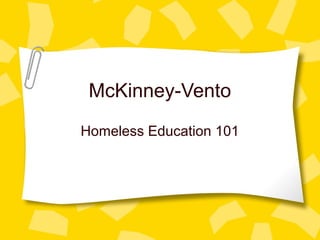Melden
Teilen

Empfohlen
Empfohlen
Weitere ähnliche Inhalte
Was ist angesagt?
Was ist angesagt? (19)
Cross Culture Understanding (CCU) Family : Types and Traditions in America

Cross Culture Understanding (CCU) Family : Types and Traditions in America
Reinstatement of Parental Rights as a Viable Permanency Option 

Reinstatement of Parental Rights as a Viable Permanency Option
Andere mochten auch
Andere mochten auch (9)
Dr ghazy 2012 my implant lecture for 4th year students

Dr ghazy 2012 my implant lecture for 4th year students
Ähnlich wie MV presentation Fall 2013
Ähnlich wie MV presentation Fall 2013 (20)
New Jersey Division of Child Protection and Permanency v.T.docx

New Jersey Division of Child Protection and Permanency v.T.docx
Pre-Conference Session: HEARTH Implications for Youth (Moody)

Pre-Conference Session: HEARTH Implications for Youth (Moody)
SWCA 301 M1.docx Adocelcent ........................................

SWCA 301 M1.docx Adocelcent ........................................
MV presentation Fall 2013
- 2. What we believe is homeless..
- 3. Reality
- 4. Who is homeless? Individuals who lack a fixed, regular and adequate nighttime residence and includes……. – Children and youth who are sharing the housing of other persons due to loss of housing, economic hardship or other similar reason; are living in motels, hotels, trailer parks or camping grounds due to lack of alternate accommodations; are living in emergency or transitional shelters; are abandoned in hospitals; or are awaiting foster care placement;
- 5. Who is homeless? Children and Youth who have a primary nighttime residence that is a public or private place not designed for or ordinarily used as a regular sleeping accommodation for human beings… Who are living in cars, parks, public spaces, abandoned buildings, substandard housing, bus or train stations, or similar settings; and Migratory children qualify as homeless because the children are living in circumstances described above.
- 6. Who is homeless? Unaccompanied Youth – Includes youth in homeless situations who are not in physical custody of a parent or guardian. – Lack safe and stable living environment – Primary reason for homelessness is physical and sexual abuse by parent or guardian, neglect, parental substance abuse, and family conflict.
- 7. Who is homeless? Preschool children, migrant children, and youth whose parents will not permit them to live at home or who have run away from home (even if their parents are willing to have them return home) are considered homeless if they fit the definition.
- 8. What Stressors do Children in homeless situations experience? Transient/unstable lifestyle Living in crowded conditions Frequently changing schools Inadequate personal hygiene Shabby or unclean clothing Poor health/nutrition Sporadic school enrollment/attendance
- 9. Basic Information The federal Mckinney-Vento Homeless Education Assistance Improvements Act and Texas state law protect the rights of homeless children and youth to receive a free and appropriate public education. Nearly everyone in Texas who is between the ages of 5 and 21 on September 1 of the school year and has not been expelled has the right to attend school, even if they: don't have a permanent address have a previous address in another town or state don't live with a parent or legal guardian live temporarily doubled-up with friends or family sleep in a shelter sleep in a campground, car, abandoned building, or other facility not designated for, or ordinarily used as regular accommodations for, human beings don't have school records
- 10. How do we identify them? An SRQ is administered to every student So c ia l wo rke rs a re tra ine d to id e ntify th e s e s tud e nts
- 11. How do social workers help? Immediate enrollment Choice of Schools Transportation Services Free Lunch Dispute Resolution